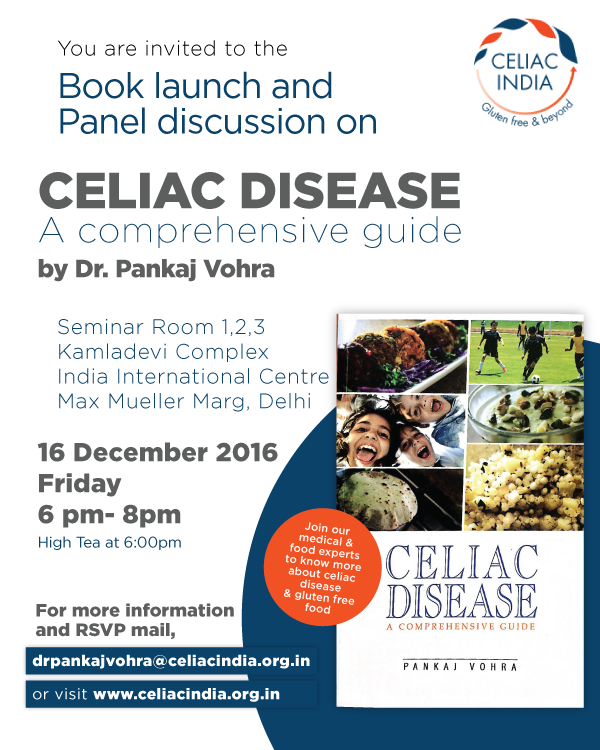Q & A with GIG – Testing products for gluten

Our first interaction with Gluten Intolerance Group begins with questions about testing of packaged food products for gluten content. Since testing is a relatively unknown area for most of us here, we will start with basic questions in our first Q & A.Feel free to post any query or comment regarding this topic at
glutenfree@celiacindia.org.in.
How can gluten content be tested in a product?
GIG: Since the introduction of gluten free (GF) diets various methods have been developed to detect gluten (and its fractions gliadin and glutenin) in raw as well as manufactured foods. The two commonly and more accurate used methods are ω-Gliadin ELISA and R5 ELISA. These methods are based on monoclonal antibodies to ω-gliadin and a celiac epitope, QQPFP, respectively. This epitope is present in wheat gliadins, barley hordeins and rye secalins. Both methods can quantitate gluten from foods at 5 ppm.
Other available methods:
Lateral flow tests (ELISA) – dipstick format (one line = negative test, 2 lines = positive test)
Polymerase chain reaction (PCR) – detects DNA, not protein
Adenosine triphosphate (ATP) – swabs for equipment cleanliness (positive ATP = positive protein, negative ATP does not always mean negative gliadin because these tests are not as sensitive)
Which is the most well accepted and recognized method for testing gluten?
GIG:The R5 ELISA test is considered the gold standard for gluten testing by Codex
Can you tell us more about the home test?
GIG: The home tests are all lateral flow devices (dipstick method). It consists of a dilution solution, extraction solution and the test strips that indicate positive or negative result. A small amount (about 0.2 ounces) of the pulverized food is added to the extraction solution. It is allowed to stand for 10 minutes before this solution is mixed with the dilution solution. As soon as the food is added, the solution may turn frothy, so care should be taken to avoid the froth (and taking just liquid) while adding it to the dilution solution. Drops of this mixed solution are then added to the strip, which will indicate the result after 10 minutes.
Why are the home tests not recommended?
GIG: Home tests are not recommended due to a number of factors, such as: validity (these tests require the food be pulverized for accurate results, which in many cases may not be possible) and accuracy (false positive or a false negative likely due to contaminated hands and surfaces). The cost (home tests run from anywhere between $10-15) and convenience (each food uses a test, so in a restaurant setting it may not be convenient to carry 3-4 tests).
Do companies conduct tests in house?
GIG: Many manufacturers lack the sophisticated equipment needed to run accurate tests, and so more often than not companies send samples of food to gluten testing laboratories.
Are naturally gluten free foods also tested for gluten?
GIG: Many naturally gluten free foods may also be tested for there could be a possible cross contamination. Also, many inherently GF foods that are manufactured may have wheat added as a thickener, binder, replacer, etc. which make it unsuitable for people on gluten free diets.
What is the gluten level used as a standard for labeling products gluten-free?
GIG:In August, 2013 the United States Food and Drug Administration (FDA) finalized its gluten-free labeling regulation. The regulation defines the characteristics FDA-regulated foods must have to be labeled “gluten-free.” To meet the FDA definition, foods must contain less than 20 ppm of gluten as well as meet other criteria. The regulation takes effect in August, 2014. (The majority of packaged foods in the U.S. are regulated by the FDA.) For more information -http://www.fda.gov/Food/GuidanceRegulation/GuidanceDocumentsRegulatoryInformation/Allergens/ucm362510.htm. The Codex definition is nearly identical, with 20 ppm being the upper limit for foods labeled gluten-free. (20 ppm gluten = 0.002% or 20 mg/kg of food). Many studies have shown that patients with celiac disease, when challenged with 50 mg of gluten/day for a finite period, have shown morphological changes (villous height) and/or symptoms, which were significant. To provide a margin of safety, these regulatory agencies have therefore established 20 ppm as the threshold for defining gluten-free.
The Gluten Intolerance Group’s certifying arm, GFCO (the Gluten-Free Certification Organization), sets an even lower threshold – ≤10 ppm.
What is the procedure for certifying a product gluten free through the GFCO program?
GIG: Companies/manufacturing facilities wanting to be certified, fill out an application through GFCO, which requires manufacturers to provide information about their product(s) and facility. After initial contact, the GFCO conducts an on-site visit and inspects the facility and the products for contamination. Ingredients are reviewed, and products are tested using any of the aforementioned methods before the products are branded ‘gluten free’. However, many sites also require more than one visit, which may be unannounced. Auditors (hired by GFCO), who have a plethora of experience in doing audits for food companies worldwide conduct the process.
Is only the final product tested?
GIG: No, testing is for the entire process — supply chain, production and final product.
The amount of testing conducted and at what critical points in the process helps to assure ‘due diligence’ is being followed in order to assure safety of foods and other products. More the testing done at different phases of production, more the assurance that the product’s safety is maintained.
GFCO looks at all of these factors when determining the requirements for a company’s certification agreement. GFCO also periodically pulls products from the “point of sale”, sending them to various labs for independent testing using R-5 Elisa analysis and other testing as needed.
Why do companies opt for certification?
GIG: No, testing is for the entire process — supply chain, production and final product
GIG: The GFCO gluten-free logo stands for the independent verification of quality, integrity, and purity of products. Products carrying the GFCO logo represent unmatched reliability and for meeting strict gluten-free standards.
The peace of mind certification would provide for children and adults with CD would be immense. The certification also means that the quality standards that the company uses in manufacturing products are at par with global standards.
How many products have been certified gluten free by GIG?
GIG:There are more than 18,000 products which have so far been certified gluten free by GIG.
Cross contamination is an important area for testing for gluten free certification. Read our next Q & A to learn about:
- What is cross contamination?
- How does it take place?
- What can be some measures to control cross contamination?
And much more……

